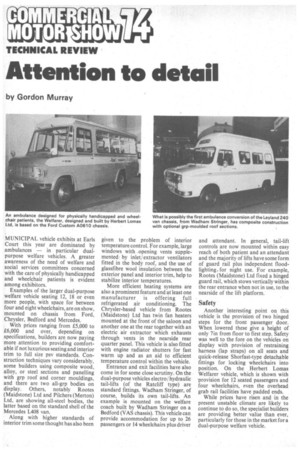TECHNICAL REVIEW•
Page 58

If you've noticed an error in this article please click here to report it so we can fix it.
Attention to detail
by Gordon Murray
MUNICIPAL vehicle exhibits at Earls Court this year are dominated by ambulances — in particular dualpurpose welfare vehicles. A greater awareness of the need of welfare and social services committees concerned with the care of physically handicapped and wheelchair patients is evident among exhibitors.
Examples of the larger dual-purpose welfare vehicle seating 12, 18 or even more people, with space for between four and eight wheelchairs, are on show, mounted on chassis from Ford, Chrysler, Bedford and Mercedes.
With prices ranging from £5,000 to £6,000 and over, depending on specifications, builders are now paying more attention to providing comfortable if not luxurious seating and interior. trim to full size psv standards. Construction techniques vary considerably, some builders using composite wood, alloy, or steel sections and panelling with grp roof and corner mouldings, and there are two all-grp bodies on display. Others, notably Rootes (Maidstone) Ltd and Pilchers (Merton) Ltd, are showing all-steel bodies, the latter based on the standard shell of the Mercedes L408 van.
Along with higher standards of interior trim some thought has also been given to the problem of interior temperature control. For example, large windows with _opening vents supplementedby inlet/ extractor ventilators fitted in the body roof, and the use of glassfibre wool insulation between the exterior panel and interior trim, help to stabilize interior temperatures.
More efficient heating systems are also a prominent feature and at least one manufacturer is offering full refrigerated air conditioning. The Chrysler-based vehicle from Rootes (Maidstone) Ltd has twin fan heaters mounted at the front of the saloon and another one at the rear together with an electric air extractor which exhausts through vents in the nearside rear quarter panel. This vehicle is also fitted with engine radiator shutters for fast warm up and as an aid to efficient temperature control within the vehicle.
Entrance and exit facilities have also come in for some close scrutiny. On the dual-purpose vehicles electro/ hydraulic tail-lifts (of the Ratcliff type) are standard fittings. Wadham Stringer, of course, builds its own tail-lifts. An example is mounted on the welfare coach built by Wadham Stringer on a Bedford (VAS chassis). This vehicle can provide accommodation for up to 26 passengers or 14 wheelchairs plus driver and attendant. In general, tail-lift controls are now mounted within easy reach of both patient and an attendant and the majority of lifts have some form of guard rail plus independent floodlighting, for night use. For example, Rootes (Maidstone) Ltd fixed a hinged guard rail, which stows vertically within the rear entrance when not in use, to the nearside of the lift platform.
Safety
Another interesting point on this vehicle is the provision of two hinged steps for the front passenger door. When lowered these give a height of only 7in from floor to first step. Safety was well to the fore on the vehicles on display with provision of restraining harness (lap straps) on all seats and quick-release Shorfast-type detachable fittings for locking wheelchairs into position. On the Herbert Lomas Welfarer vehicle, which is shown with • provision for 12 seated passengers and four wheelchairs, even the overhead grab rail facilities have padded ends.
While prices have risen and in the present unstable climate are likely to continue to do so, the specialist builders are providing better value than ever, particularly for those in the market for a dual-purpose welfare vehicle.




























































































































































